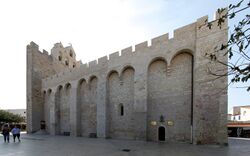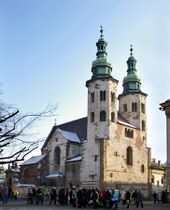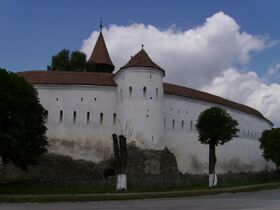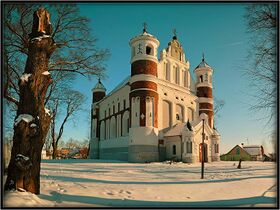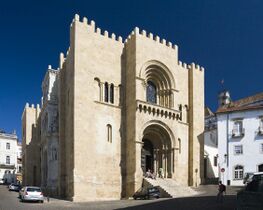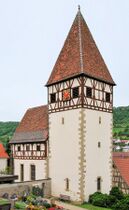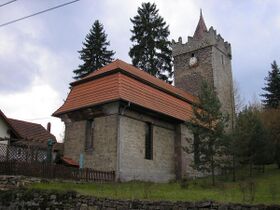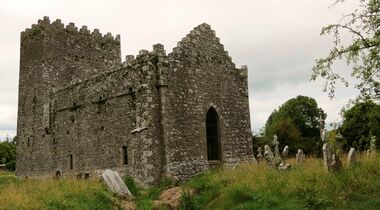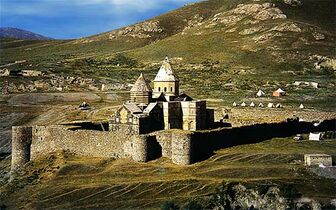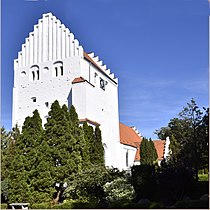Religion:Fortified church
A fortified church is a church that is built to serve a defensive role in times of war. Such churches were specially designed to incorporate military features, such as thick walls, battlements, and embrasures. Others, such as the Ávila Cathedral were incorporated into the town wall. Monastic communities, such as Solovki Monastery, are often surrounded by a wall, and some churches, such as St. Arbogast in Muttenz, Switzerland , have an outer wall as well. Churches with additional external defences such as curtain walls and wall towers are often referred to more specifically as fortress churches or Kirchenburgen (literally "church castles").
Most fortified churches may be found in parts of Europe In times were there was much hand-to-hand warfare,[clarify] for example in the Dordogne region of France , fought over by France and England in medieval times, and in Transylvania, during the Ottoman invasions.[citation needed] Fortified churches were also built in places controlled by colonial empires, such as one in the Philippines at the scene of the siege of Baler.[citation needed]
Belarus
Although many fortified churches in various styles existed in the lands of Belarus , only a handful survived until the present. The most famous include Christian Orthodox churches in Muravanka, and Synkavichy, as well as Catholic fortified churches in Kamai and Ishkold'. In addition to Christian churches Belarus also has the ruins of several fortified synagogues, of which the Chief Synagogue in Bykhaw is most notable.[1]
France
About 65[2] fortified churches are found in the Thiérache region of northern France, near the Belgian border. They were built here because it was a major land passage on the border between Champagne and Picardy.[3] As a result, the area was frequently under attack.
Germany
Several fortified churches have been preserved, especially in the German states of Baden-Württemberg, Bavaria and Hesse. Examples are the churches of Kleinbreitenbach in Plaue, Kößlarn, Grafengehaig, Großrückerswalde, Mittelsaida, Büchenbach/Erlangen, Kriegenbrunn/Erlangen, Morsbach/Künzelsau, Espendfeld/Arnstadt, Finkenbach-Gersweiler, St. Wolfgang in Rothenburg, and the fortified church of Wenkbach.
Ireland
Several fortified churches survive from the medieval period, including Hospital Church (Knights Hospitaller), Taghmon Church, Old St. Mary's Church, Clonmel and St Finian's Church, Newcastle.
Poland
A rare surviving example of a fortress church used for defensive purposes is the Church of St. Andrew in Kraków, one of the oldest and best preserved Romanesque buildings in Poland . Located at ul. Grodzka street, it was built by a medieval Polish statesman Palatine Sieciech in 1079–1098. St. Andrew was the only Romanesque church in Kraków to withstand the Mongol attack of 1241.
Portugal
Some medieval fortified churches, monasteries, and cathedrals survive in Portugal. These buildings were built either in Romanesque or Gothic styles. Romanesque examples are the Lisbon Cathedral and the Old Cathedral of Coimbra. Gothic examples are the Church of Leça do Balio and the Guarda Cathedral.
Romania
The southeastern Transylvania region in Romania has among the highest numbers of existing fortified churches from the 13th to 16th centuries.[4] More than 150 villages in the area count various types of fortified churches, seven of them being included in the UNESCO World Heritage under the name of Villages with fortified churches in Transylvania.
Russia
Medieval limestone churches of Russia sometimes resembled towers and could be used for defensive purposes.[5] At least three churches in the Moscow and Tver regions have been described as purpose-built defensive structures: namely, Kamenskoye Church, Gorodishche Church, and Gorodnya Church.[6]
Slovenia
During the Ottoman-Habsburg Wars from the late 15th to the late 17th century, the Slovene Lands were subjected to constant Ottoman raids, which reached their peak in the late 15th and early 16th century. During that period, around 300 village churches were fortified in the territory of present-day Slovenia, with another 50 in the neighboring area of southern Carinthia.[7]
They were known as tabors (which in modern Slovene means "camp"). A dozen of such churches remain today, the most famous of which are the Holy Trinity Church in Hrastovlje, Mount Saint Mary near Ljubljana, and Podbrezje in Upper Carniola.
In some cases, entire villages were fortified. Remaining examples are Šmartno in the Gorizia Hills, and Štanjel.
Ukraine
In Ukraine fortified churches were mostly constructed in a time period between the late 14th and the late 17th century in the western and central parts of modern Ukraine, most notably Galicia[8] and Dnieper Ukraine.[9] Some of this churches were constructed atop of existing fortifications and were extensively modified in later years, sometimes loosing their sturdy appearance.

United Kingdom
There are several medieval fortified churches near the Anglo-Scottish border, where defence was an important consideration until the 17th century, when England and Scotland were united in personal union under King James VI and I. All Saints' Church, Boltongate in Cumbria is a fortified church with a fireproof stone-vaulted roof. Also in Cumbria, St Michael's Church, Burgh by Sands has a defensive tower, and originally had two. The west tower retains its yett, a door made of interlocking iron bars to repel attackers. An even more formidable yett can be seen at St Cuthbert's Church, Great Salkeld, where the ground floor of the tower is tunnel-vaulted, and supports a fireplace above, enabling the tower to be habitable as a place of refuge. The tower of St John the Baptist's Church in Newton Arlosh is also tunnel-vaulted with very small windows, and has no outer doorway to the churchyard. Entry was inside at first-floor level.
Defensive towers can also be found on the England–Wales border, for instance St Michael's Church, in Garway, Herefordshire.[10]
Gallery
Fortified church in Muttenz, Switzerland
Holy Trinity Church in Hrastovlje, Slovenia
Castle-church of Rudelle, France
St. Andrew's Church, Kraków, Poland
All Saints Church, Boltongate, England, with defensive parapet
Østerlars Church in Bornholm, Denmark
Solna Church close to Stockholm, Sweden
Fortified church of St. Louis in Baler, Philippines .
See also
- Saint Catherine's Monastery
- Tangyud Monastery
- Video Fortified churches in Transylvania
Notes and references
- ↑ (in Russian) List of fortified churches in Belarus
- ↑ (in fr) Les Églises fortifiées de la Thiérache - Guide de découvertes | Sites de Mémoire, balades et circuits - Coll. Guide Pays côté Histoire. Chamina. 2006. ISBN 2-84466-110-6.
- ↑ "Architecture in France: the churches of the north east". https://www.connexionfrance.com/article/Practical/Property/the-history-of-the-architecture-of-french-fortified-churches.
- ↑ Villages with Fortified Churches in Transylvania. UNESCO World Heritage Centre 1992-2010
- ↑ "РусАрх - Заграевский С.В. К вопросу о древнерусских оборонных монастырях и храмах". http://rusarch.ru/zagraevsky33.htm.
- ↑ Заграевский С.В. Зодчество Северо-Восточной Руси конца XIII–первой трети XIV века. М., 2003. С. 51.
- ↑ Drago Bajt & Marko Vidic, eds., Slovenski zgodovinski atlas (Ljubljana, 2011), p. 95
- ↑ "ОСОБЛИВОСТІ АРХІТЕКТУРНО-ПРОСТОРОВОГО ВИРІШЕННЯ ОБОРОННИХ ХРАМІВ ГАЛИЧИНИ". http://irbis-nbuv.gov.ua/cgi-bin/irbis_nbuv/cgiirbis_64.exe?C21COM=2&I21DBN=UJRN&P21DBN=UJRN&IMAGE_FILE_DOWNLOAD=1&Image_file_name=PDF/VNULPARX_2015_836_27.pdf.
- ↑ "Колекція найгарніших церков України | Андрій Бондаренко - подорожі Україною і світом". http://andy-travel.com.ua/kolekciya-naygarnishih-cerkov-ukrayini. Retrieved 2019-01-28.
- ↑ Resources, www.users.globalnet.co.uk
 |
